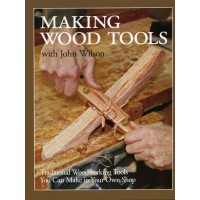We may receive a commission when you use our affiliate links. However, this does not impact our recommendations.
 I’ve turned hollow mortise chisels into square punches, refashioned chisels and their handles, made a number of scratch stocks, ground steel bar stock into embossing punches and a made a few other quick tools. And I’ve built a few wooden, Krenov-style handplanes over the years – I had a fine time and wound up with a few serviceable tools, but for the most part I’ve avoided the bug for obsessive tool making that I’ve seen and often envied in others.
I’ve turned hollow mortise chisels into square punches, refashioned chisels and their handles, made a number of scratch stocks, ground steel bar stock into embossing punches and a made a few other quick tools. And I’ve built a few wooden, Krenov-style handplanes over the years – I had a fine time and wound up with a few serviceable tools, but for the most part I’ve avoided the bug for obsessive tool making that I’ve seen and often envied in others.
But at the recent Woodworking in America show in Northern Kentucky I revived a little excitement toward making my own tools. First, I spent a little time at the booth of Scott Meek, a furniture and handtool maker from Asheville, N.C. Scott makes some beautiful wooden hand planes – their look, feel and performance is stunning, and there is something about the feel of a wooden plane that can’t be replicated in other tools. While I don’t expect to make anything like Scott’s planes right out of the chute (or ever), I did think, “Boy I need to give this another shot.” So when I returned I took close look at a new book from John Wilson called “Making Wood Tools: Traditional Woodworking Tools You Can Make in Your Own Shop.” You probably know Wilson from his Shaker oval box fame (and here’s a great DVD from Wilson on “Making Shaker Oval Boxes and Carriers”), but he may soon be as well known for teaching tool making.
This is just the kind of no-nonsense instruction I love. While Scott Meek and other makers have really honed the craft, Wilson’s book gives you all the technical info you need to understand the basics – from stock selection to all the key angles necessary for making successful tools. He even includes a straightforward process for making your own O1 blades, which I am really itching to adapt to make a set of chisels. John gives you the basics, and you’re free to make tools as rudimentary or refined as you’d like.
Aside from handplanes (block, chisel, compass, jack, scrub, smoothing and router planes), Wilson also shows you how to make spokeshaves, travishers, a bow saw, scrapers and an adze. After talking you through making tools and blade making basics, Wilson also has a section on workholding in which he has plans for a workbench, sawbench, dovetailing workhorse, chisel holders, tool totes and various other shop staples. If you’re at all interested in making your own tools, you should have this book on your shelf. It’s on mine, but I hope to have it spread open on my workbench soon.
Here are some supplies and tools we find essential in our everyday work around the shop. We may receive a commission from sales referred by our links; however, we have carefully selected these products for their usefulness and quality.








